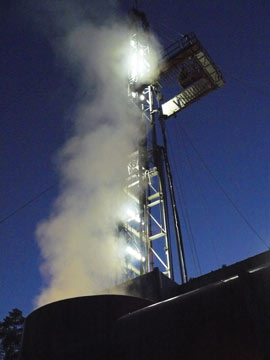|
NEWS NOTES
Europe’s deep energy
 GFZ Potsdam |
| German researchers hope that this well — one of two 4.3-kilometer-deep wells that tap into water trapped in hot rocks in Groß Schönebeck’s geothermal “laboratory” — will help them better understand the geothermal potential of the region. |
Fifty kilometers northeast of Berlin, in the small village of Groß Schönebeck, Germany, lies an in situ geothermal laboratory. In the 1990s, a company drilled a 4.3-kilometer-deep borehole into the ground in search of natural gas. Shortly thereafter, the company abandoned the well because it wasn’t producing. But experts in geothermal energy at the German Center for Earth Science Research in Potsdam saw opportunity in that abandoned well: It could help them explore the geothermal energy potential of the region — and of much of the rest of Europe, which has similar geology.
Geothermal energy is relatively easy to develop in volcanic regions, where magma heats water circulating near the surface. Steam from that water can then be extracted and used to drive turbines and generate electrical power. Non-volcanic regions in Central and Western Europe like Groß Schönebeck, however, may still contain sufficient heat for geothermal — albeit much deeper underground.
Producing the geothermal energy from these deep resources is a bit more complicated. One method, called enhanced geothermal systems, requires two wells: one to draw hot water out of the deep aquifers, and the second to inject cooled water back into the ground after use in a power plant. To be commercially viable, the extracted water has to be both hot enough (at least 150 degrees Celsius) and flow fast enough to produce electricity.
That’s where Groß Schönebeck’s well came in. In 2000, geothermal researchers at the German center, led by physicist and engineer Ernst Huenges, reopened the abandoned well to study the geology of the site. Then, in 2006, the team drilled a second borehole 400 meters away, intending to install such a hot-cold water loop. To obtain as much water as possible from that deep reservoir, the researchers then injected 13,000 cubic meters of fluid into the new well.
That technique — already commonly used in the petroleum and natural gas industries — helps the water flow faster. Injecting fluids into the well at high pressures can produce cracks or extend already existing fissures in the rock, thus creating new paths through which the deep water can flow and absorb more heat from the surrounding rocks.
Last August, the team completed tests that showed that, with the help of these new fractures, both the water flow and temperature from the wells were high enough to produce geothermal energy for at least several decades. The placement of the two wells was key to their success. They were oriented so that the same tectonic forces driving the African Plate toward Eurasia (the collision that also produced the Alps) created stresses that drove the new fractures to form a conduit between the wells, and the tectonic tension helped to keep the fractures open — a necessary condition for long-term geothermal energy production.
The next step, Huenges says, will be to see if the Groß Schönebeck project can sustain both flow rate and water temperature — and, ultimately, to see if the new fractures and flow paths will allow them to draw out enough of the hot water long buried within the sediment layers. Either way, he says, Groß Schönebeck is a key part of enhanced geothermal energy’s “learning curve” in Europe.

 Subscribe
Subscribe


